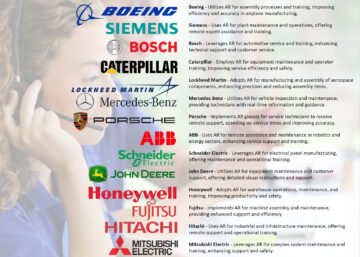“While reality is three-dimensional, the rich data we now have to inform our decisions and actions remains trapped on two-dimensional pages and screens.”
Michael Porter & James Heppelmann
Augmented Reality aims to change those limitations by merging our two-dimensional information with the three-dimensional world. Harvard Business Review (2019) predicts that AR will permeate every industry and a multitude of organizations in the coming years, including universities and social enterprises. And nowhere is AR’s impact on human performance more obvious than in manufacturing.
Augmented Reality and Manufacturing
AR’s overlay of digital information on a real-world environment helps technicians prevent mistakes and work more efficiently. It’s already at work in some sectors. Newport News Shipbuilding, a designer of U.S. Navy aircraft carriers, uses AR to inspect newly built ships. The digital projections highlight construction structures, not part of the finished product, that must be removed. Previously, engineers compared the finished ship against its 2-D blueprints, a process that took around 36 hours. AR has reduced that inspection time to just 90 minutes. (Harvard Business Review, 2019)
Augmented Reality Product Demos
AR’s digital augmentation can make providing a demo for a client in any industry easy and cost-effective. Bosch Rexroth uses AR enhancement to demonstrate the CytroPac hydraulic power unit. Their customers see a 3-D representation of the unit’s pump and cooling options. The AR image of the system can be manipulated and reconfigured to customers’ individual specifications in an instant. (Harvard Business Review, 2019) With AR, there is no need to create and transport expensive, bulky prototypes to the customer, and the AR representations are far superior and more dynamic than any two-dimensional schematic.
Training with Augmented Reality
When a company needs to train employees at a distance, instruction manuals and video education is the norm, but these are not interactive, nor do they adapt to individual learning styles. Assembly instructions can be cumbersome and time-consuming to follow. AR instruction is real-time and projected onto the actual environment, providing step-by-step instructions right on the equipment. Boeing has used AR training for some of its aircraft manufacturing procedures. AR instruction walked trainees through a 50-step wing assembly process and cut assembly time down by 35 percent over 2-D instructions. The number of first-time assemblers who did it correctly increased by 90 percent. (Harvard Business Review, 2019)
Augmented reality, as is apparent, boosts speed and accuracy in the manufacturing process, not to mention cost savings in product demos. Merging digital information with real-world products increases our ability to absorb information and quickly and accurately apply it to the object in front of us. Amazon, Facebook, General Electric, Mayo Clinic and the U.S. Navy are using AR to their advantage already. It’s only a matter of time before it becomes ubiquitous.



